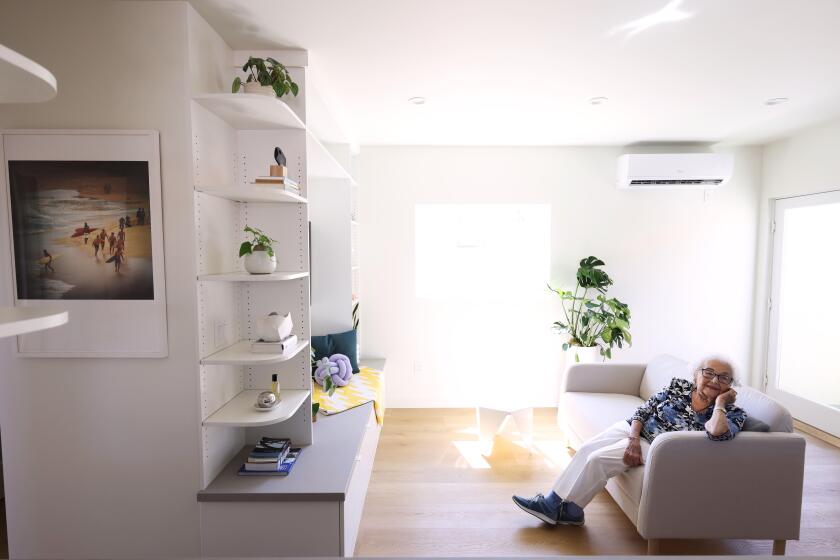A Celebration of Our Ethnic Variety : Above Freeway, Living Gateway Will Be City’s Crown Jewel
When Mayor Tom Bradley proposed the construction in Los Angeles of “a symbolic monument to welcome immigrants to America’s shore,” the headlines read: “ ‘Liberty’ of West urged by Bradley”; “L.A. to plan its version of Lady ‘Liberty’ .” The monument was perceived then to be a static structure or a sculpture, maybe a statue, that would complement a local park, rise over L.A. Harbor or be placed atop a hill overlooking LAX.
However, the blue-ribbon committee appointed by the mayor to find a location and come up with a design immediately came to the conclusion that Los Angeles does not need a static edifice, a monument in the conventional sense, that would fit in cities like Rome, Paris or Athens. The committee decided to propose instead a living, utilitarian reminder of our diverse cultural heritage--a continuous, evolving source of learning and appreciation of our collective national identity; a landmark that would be a rallying point for the community; a public place that would bring people together in a renewed spirit of pride and cooperation; a symbol that will reflect all the values and institutions related to America’s traditional hospitality toward immigrants, refugees, visitors and international events.
Once the general concept of the project was developed, the next step was to find an appropriate location. A number of criteria were set forth: accessibility, visibility, readily available land, minimum environmental impact, expansion potential, appropriate size, proximity to other strategic areas and beneficial to the local community.
Because Union Station will be the transportation hub of Los Angeles County with the completion of Metro Rail and light-rail lines, locating the project there would make it easily accessible. We determined that this location also met the other criteria and has some unique features. It is near the Civic Center, one of the largest concentrations of government offices outside of Washington. Three ethnic districts are within walking distance--Chinatown, El Pueblo Historic Park (Olvera Street) and Little Tokyo. If we were to connect these three ethnic islands, we could designate that area as our “monument.” Inexpensive ideas, such as banners, posters, the painting of existing streets and alleys through these areas, awning designs, landscaping, fountains, play zones and performance spaces would actually and symbolically link the ethnic roots of Los Angeles.
There is, however, a physical obstacle to the “connector” scheme. A river of cars separates Little Tokyo from Olvera Street and Chinatown. This river is the Hollywood Freeway, a psychological and physical barrier between the north and south sections of our city. If we were to build a bridge over the freeway, the connection would be complete. A big challenge, but what a fantastic opportunity it is to build a public space on top of the freeway; and so, the West Coast Gateway was born--the crown jewel of the “monument.”
Financed with private-sector funds, the project would accomplish many objectives. It will humanize downtown, connect the ethnic districts of Los Angeles symbolically and physically, celebrate the city’s ethnic diversity, bring people together and create a festive environment, and at the same time, provide revenue to the state (the air space over the freeway will be leased from the California Department of Transportation).
Above all, the Gateway will be a living monument. Visitors will be able to experience the sounds, tastes and smells of the world; many could learn about their heritage, either as individuals or as an ethnically or culturally linked group. We will be able to relax, reflect, learn about other cultures or meet other people in the open and shaded plazas. Art lovers will be able to enjoy the works of visual artists, sculptors, ceramists and artisans of all kinds. With the aid of an information center, tourists of whatever nationality, race or culture would be able to explore the Gateway and the city without confusion or anxiety. Ethnic festivals, naturalization ceremonies, and greetings for heads of state, international dignitaries, diplomats and citizens of distinction could also be conducted at the Gateway.
The Gateway, like other civic milestones of our past, will be completed through the same stamina, fortitude and dedication that others before us have displayed. The Gateway will be a living monument that will stand as a testimonial to the human spirit and in celebration of the achievements of the citizens of this great city. The Gateway will be designed to fulfill the needs and aspirations of many people in our city, and will provide an opportunity for all of us, whether we have come from another country or another state, to express our gratitude and appreciation for having experienced, each in our own way, the American dream.
More to Read
Sign up for Essential California
The most important California stories and recommendations in your inbox every morning.
You may occasionally receive promotional content from the Los Angeles Times.









